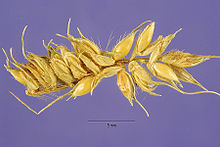| Echinochloa stagnina | |
|---|---|
 | |
| Seeds of Echinochloa stagnina | |
| Scientific classification | |
| Kingdom: | Plantae |
| Clade: | Tracheophytes |
| Clade: | Angiosperms |
| Clade: | Monocots |
| Clade: | Commelinids |
| Order: | Poales |
| Family: | Poaceae |
| Subfamily: | Panicoideae |
| Genus: | Echinochloa |
| Species: | E. stagnina |
| Binomial name | |
| Echinochloa stagnina | |
Echinochloa stagnina (Burgu millet, bourgou, hippo grass) is a species of Echinochloa widespread in tropical Africa and Asia, with an invasive status in many Pacific islands.[1]
It was once one of the major grasses cultivated in the Inner Niger Delta of the Niger River. It was cultivated by the Fulani people, who used the seeds as food, and to make both alcoholic and nonalcoholic beverages.
It tolerates floods well, and has been replanted in Africa, where it has helped to control erosion and provides hay for animals.
Local names:
- Fula: burgu
- Laotian: ປ້ອງ [pɔ̂ːŋ].
Uses
A traditional food plant in Africa, this little-known grain has potential to improve nutrition, boost food security, foster rural development and support sustainable landcare.[2]
References
- ^ Pacific Island Ecosystems at Risk (PIER) Fact sheet on Echinochloa stagnina
- ^ National Research Council (1996-02-14). "Wild Grains". Lost Crops of Africa: Volume I: Grains. Lost Crops of Africa. 1. National Academies Press. p. 266. ISBN 978-0-309-04990-0. Retrieved 2008-07-18.
External links
![]() Media related to Echinochloa stagnina at Wikimedia Commons
Media related to Echinochloa stagnina at Wikimedia Commons